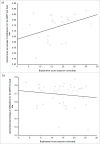Combined epigenetic and intraspecific variation of the DRD4 and SERT genes influence novelty seeking behavior in great tit Parus major
- PMID: 25933062
- PMCID: PMC4622863
- DOI: 10.1080/15592294.2015.1046027
Combined epigenetic and intraspecific variation of the DRD4 and SERT genes influence novelty seeking behavior in great tit Parus major
Abstract
DNA methylation is one of the main epigenetic mechanisms that can regulate gene expression and is an important means for creating phenotypic variation. In the present study, we performed methylation profiling of 2 candidate genes for personality traits, namely DRD4 and SERT, in the great tit Parus major to ascertain whether personality traits and behavior within different habitats have evolved with the aid of epigenetic variation. We applied bisulphite PCR and strand-specific sequencing to determine the methylation profile of the CpG dinucleotides in the DRD4 and SERT promoters and also in the CpG island overlapping DRD4 exon 3. Furthermore, we performed pyrosequencing to quantify the total methylation levels at each CpG location. Our results indicated that methylation was ∼1-4% higher in urban than in forest birds, for all loci and tissues analyzed, suggesting that this epigenetic modification is influenced by environmental conditions. Screening of genomic DNA sequence revealed that the SERT promoter is CpG poor region. The methylation at a single CpG dinucleotide located 288 bp from the transcription start site was related to exploration score in urban birds. In addition, the genotypes of the SERT polymorphism SNP234 located within the minimal promoter were significantly correlated with novelty seeking behavior in captivity, with the allele increasing this behavior being more frequent in urban birds. As a conclusion, it seems that both genetic and methylation variability of the SERT gene have an important role in shaping personality traits in great tits, whereas genetic and methylation variation at the DRD4 gene is not strongly involved in behavior and personality traits.
Keywords: DRD4; SERT; methylation; novelty seeking; personality traits; urbanization.
Figures




References
-
- Felthous A, Sass H. International Handbook on Psychopathic Disorders and the Law; Chichester: John Wiley & Sons: 2007; Vol. 1, Diagnosis and Treatment.
-
- Reif A, Lesch KP. Toward a molecular architecture of personality. Behav Brain Res 2003; 139(1):1-20; PMID:12642172; http://dx.doi.org/10.1016/S0166-4328(02)00267-X - DOI - PubMed
-
- Bailey JN, Breidenthal SE, Jorgensen MJ, McCracken JT, Fairbanks LA. The association of DRD4 and novelty seeking is found in a nonhuman primate model. Psychiat Genet 2007; 17(1):23-7; PMID:17167341; http://dx.doi.org/10.1097/YPG.0b013e32801140f2 - DOI - PubMed
-
- Van Gestel S, Van Broeckhoven C. Genetics of personality: are we making progress? Mol Psychiat 2003; 8(10):840-52; PMID:14515135; http://dx.doi.org/10.1038/sj.mp.4001367 - DOI - PubMed
-
- Schinka JA, Letsch EA, Crawford FC. DRD4 and novelty seeking: results of meta-analyses. Am J Med Genet 2002; 114(6):643-8; PMID:12210280; http://dx.doi.org/10.1002/ajmg.10649 - DOI - PubMed
Publication types
MeSH terms
Substances
LinkOut - more resources
Full Text Sources
Other Literature Sources
Research Materials
